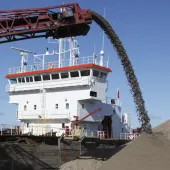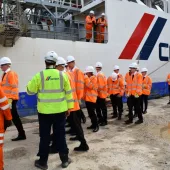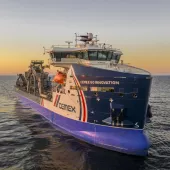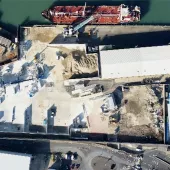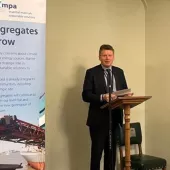The Continuing Recovery in the UK Marine Aggregates Sector
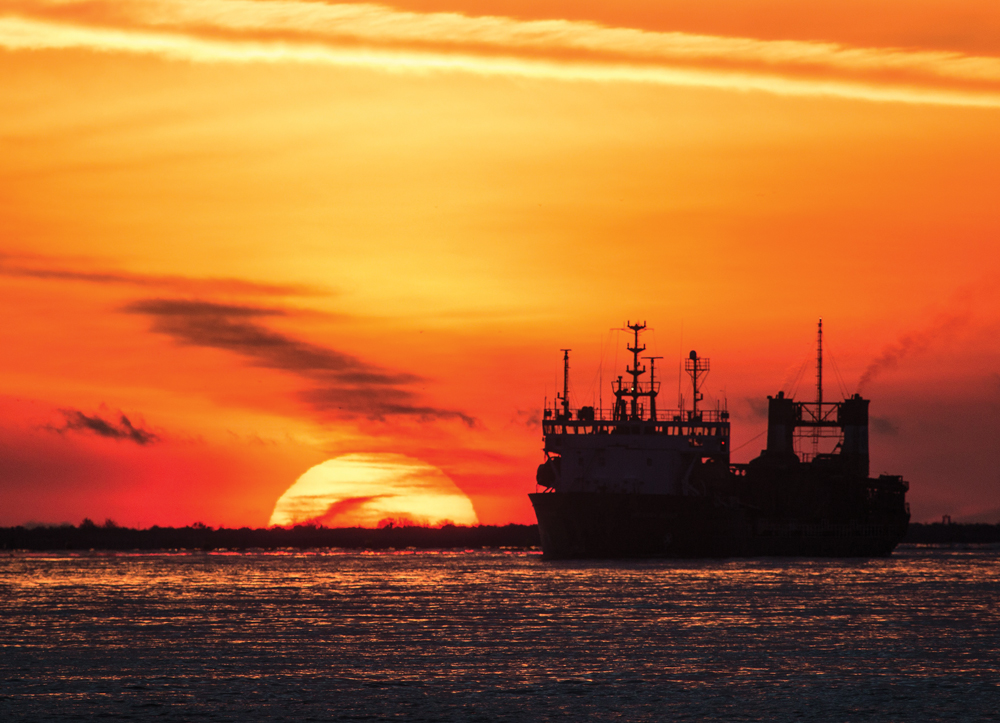
First published in the May 2016 issue of Quarry Management as Looking to the Horizon
Mark Russell, MPA executive director - planning, mineral resources & BMAPA, reports on the continuing recovery in the UK marine aggregate sector and highlights two key watershed moments that will affect the future shape and direction of the industry
The UK marine aggregate sector published its ninth annual sustainable development report in December 2015, part of a wider initiative established by the British Marine Aggregate Producers Association’s (BMAPA) parent organization, the Mineral Products Association.
The ninth annual report builds on the sector’s sustainable development strategy launched in October 2006. Under this commitment, individual marine aggregate operators continue to report a wide range of data which, when combined, provides a comprehensive record of the sustainable development performance of the sector as a whole. A series of key performance indicators (KPIs) encompass the themes of sustainable production, climate change and energy, natural resources and environmental protection, and creating sustainable communities. Over the years, the time-series data that have been collated have allowed trends and changes in overall industry performance to be identified.
Sustainable development initiatives for industry sectors can be particularly challenging, as it can be difficult to obtain sufficient consistent data from member companies to be representative. The fact that the ninth annual report continues to capture data from more than 75% of all marine aggregate production activity that has taken place in UK waters during 2014 reflects the importance that BMAPA members continue to place on this initiative. The balance of production activity that remains unreported largely comprises operators who sit outside BMAPA, coupled with third-party vessels working for BMAPA members on a contract basis.
The latest report showed that the encouraging signs of economic recovery observed during 2013 were maintained into 2014, with total marine aggregate production increasing by 7.6% to 17.25 million tonnes, and landings to England and Wales increasing by 11.1% to 11.81 million tonnes. In London and the south-east of England, where one third of Great Britain’s construction activity takes place and where, traditionally, marine supplies fulfil one third of all primary construction aggregate demand, marine landings increased by a healthy 13.8% to 9.9 million tonnes. Along the river Thames marine landings increased by 21% to 7.33 million tonnes, equivalent to 1,000 lorry loads being delivered by sea every day. This level of activity reflects both the scale of growth and development that is currently taking place in the capital, and also the significant enabling role that marine-dredged aggregate supplies play in support.
The Crossrail project is just one example of a major infrastructure project that is fuelling the demand for construction aggregates in London. The £14.8 billion project employs in excess of 10,000 people on 40 separate construction sites and will transform rail transport in London, increasing capacity, supporting regeneration and cutting journey times across the city. The route will extend more than 100km from Reading and Heathrow Airport in the West, through new tunnels under central London to Shenfield and Abbey Wood in the East. Some 250,000 precast concrete segments are being used to line the 42km of new tunnels that are being created. Marine-dredged aggregate supplied from Thames wharves is being used together with crushed rock to make ready-mixed concrete for access shafts, underground stations and precast tunnel segments throughout the central London underground section. Looking ahead, the Thames Tideway project is likely to maintain the demand for construction aggregates alongside the wider development and regeneration that continues to take place across the capital.
Elsewhere, the markets of the near Continent, which have historically received around a third of the UK marine aggregate sector’s total production for use as concreting aggregate, continue to contract. The 26.9% reduction in marine landings during 2014 (2.99 million tonnes) reflects the continued uncertainties in these markets, largely brought about through a contraction in public spending, and also provides some useful perspective to the relative performance of the wider UK market.
Statistics for 2015 recently published by The Crown Estate show that marine aggregate production continues to recover, with a total of 19.47 million tonnes dredged representing an increase of 12.8% compared with the previous year. Landings of marine aggregates for construction use to England and Wales (13.23 million tonnes), to London and south-east England (11.1 million tonnes) and to the Thames (8.3 million tonnes) all demonstrated significant increases. Meanwhile, the difficult market conditions on the near Continent continued, with marine landings reducing by a further 28% to 2.15 million tonnes. The balance of production was represented by 4.07 million tonnes used for a combination of contract fill and beach replenishment – with the largest component comprising 1.78 million tonnes of fill material delivered in support of the Liverpool 2 port development.
The ongoing challenges posed by rapidly changing economic conditions serve to reinforce how important it is for any industry sector to have firm foundations that allow it to plan over the short, medium and long term. In this respect, two key watershed moments have been delivered in recent years that will profoundly affect the future shape and direction of the marine aggregate industry.
Long-term reserves successfully secured
The sector has successfully completed a major programme to re-licence many of the historic resource areas that have been the mainstay of marine aggregate production activities over the last two decades for a further 15 years. Working closely with the regulator, the Marine Management Organisation (MMO), and their statutory advisors, the sector commissioned a number of regional assessments to address common environmental issues that applied to all applications. Four voluntary Marine Aggregate Regional Environmental Assessments (MAREAs) were undertaken by marine aggregate operators across the south coast, outer Thames, Anglian and Humber dredging regions, to consider the potential cumulative impacts arising from the various applications to re-licence historic licence areas, alongside applications for new areas.
Following these, a number of additional studies were commissioned to address particular regional sensitivities identified by the MAREA process, including the consideration of potential effects on various habitats and species within European marine protected sites and regional fisheries issues. The outputs from these collaborative assessments were then used to inform the site-specific environmental impact assessments (EIAs) supporting individual applications. The influence of this approach is reflected by the fact that the permitted reserve base for marine sand and gravel had increased to more than 330 million tonnes at the start of 2015. This is equivalent to a working life of more than 18 years based on the 10-year average annual production.
By working closely with regulators and their statutory advisors, to first understand the issues that needed to be addressed and then to develop and agree the scope of works required to reduce the uncertainties associated with them, the collaborative approach adopted by the marine aggregate sector has been able to deliver more consistent and proportionate regulatory outcomes for reduced time, effort and cost. As a consequence of this example of better regulation in practice, the approach is now rightly being held up as a model of best practice for the wider UK marine development sector.
Having successfully demonstrated the practical benefits of collaborative working and a more co-ordinated approach towards management, these principles are now being applied to the way the sector will undertake the monitoring and compliance responsibilities associated with the new regulatory consents over the next 15 years and beyond.
Through discussions with the MMO, statutory advisors and industry, a set of standard licence conditions have been established that apply to every marine licence issued for marine mineral extraction. These define the basic requirements for regulating, managing and monitoring marine aggregate extraction activities in English waters and ensure a consistent approach is adopted across every licence area that is permitted. This has allowed the industry to move towards commissioning the standard monitoring compliance surveys required under every marine licence on a regional basis. Again, the ability to agree monitoring specifications and commission survey works collectively delivers significant savings in time, effort and cost for both operators and regulators.
In the case of the baseline seabed monitoring surveys that have been required across all new licence areas, five regional baseline surveys across marine aggregate interests in the southern North Sea and English Channel were commissioned by the marine aggregate industry in 2014. The surveys, which commenced in August 2014 and were successfully completed in November 2015, totalled more than 3,500 individual sample stations and represented one of the largest seabed sampling surveys ever commissioned on the UK continental shelf. These data are now being processed and are expected to be reported in the first half of 2016.
Marine planning provides increased certainty for the future
The second watershed relates to the introduction of marine planning across UK waters, and associated with this, the development of marine plan policies that not only recognize the significance and importance of marine aggregate resources, but also establish new safeguarding mechanisms to ensure these valuable assets can be properly protected. Underpinning this is the UK Marine Policy Statement (UKMPS) published in 2011, which establishes the framework for preparing marine plans and for taking decisions affecting the marine environment in order to contribute to the achievement of sustainable development in the UK marine area. As well as more general policy statements around economic, social and environmental considerations, policies for individual marine sectors have been defined.
In the case of marine aggregates, the UKMPS states that: ‘The UK has some of the best marine aggregate resources in the world. Marine sand and gravel makes a crucial contribution to meeting the nation’s demand for construction aggregate materials, essential for the development of our built environment.’
The UKMPS goes on to state that: ‘Marine plan authorities should as a minimum make provision within Marine Plans for a level of supply of marine sand and gravel that ensures that marine aggregates...contribute to the overarching Government objective of securing an adequate and continuing supply to the UK market for various uses.’
Crucially, the UKMPS requires marine plan authorities and decision-makers to take into account ‘...the need to safeguard reserves for future extraction.’
The first English marine plans for the East Inshore/Offshore area, which covers a large section of the southern North Sea, has now been formally adopted and the second for the South Inshore/Offshore area, which covers the eastern section of the English Channel, is also now well advanced. Collectively, these plan areas encompass around 90% of all the permitted reserves the marine aggregate sector currently holds.
Given the distribution of commercially viable marine sand and gravel resources is highly limited, constrained by their geological distribution and their geographical position relative to market location, baseline data on the spatial distribution of marine sand and gravel resources across the marine plan areas has been mapped by the British Geological Survey under contract to The Crown Estate (the marine mineral owner). The limited spatial extent of marine sand and gravel deposits has allowed areas of potential future resource to be clearly identified so they can be incorporated into the marine planning process from the outset. This has allowed a series of marine mineral safeguarding policies to be developed which provide a tiered level of protection to areas of interest – with the strongest levels of protection against other forms of marine use and development being provided to existing licence and application interests. Importantly, the narrative behind these policies recognizes that future resource demands and requirements will inevitably evolve and change over the 20-year plan period and beyond. Collectively, these changes do much to reinforce marine aggregate operators ‘licence to operate’ and provide operators with significantly more certainty around their long-term resource assets.
The challenges to delivery have shifted
But the future now brings new challenges for the sector. With marine aggregate reserves and future resources now largely secure in the long term, focus is increasingly shifting towards the need to maintain and enhance the marine aggregate industry’s operational capability. This is both in terms of the production capacity to win the resources required and also the land-based infrastructure to allow the resources to be landed so they can reach the markets where they are needed.
The fleet of 21 purpose-built marine aggregate dredgers operated by BMAPA members’ has an average age of 20 years. With many vessels ageing, significant investment will be required over the next 5–10 years in order to maintain the production capacity that is currently available. Given that access to and security of commercially suitable marine sand and gravel resources is central to the sectors long-term viability, the confidence and certainty provided by the recent policy, planning and regulatory developments should provide an essential backdrop to help inform the investment decisions that are required.
One of the major advantages of marine aggregate supplies is the ability to deliver large volumes of sand and gravel close to the point of demand. This reduces costs and offers wider environmental benefits by reducing the need for road transport. However, traditional wharf facilities are coming under growing pressure owing to the rapid growth of new residential developments in port and river areas. While the wharf sites themselves should be protected by local safeguarding policies that recognize their strategic importance to mineral supply, in accordance with paragraph 143 of the National Planning Policy Framework, their effective operation can be rapidly compromised by inappropriate development next door. Marine planning should provide another mechanism to further reinforce the need for and importance of this key infrastructure, and in turn ensure the sustainable supply of essential construction materials can be maintained.
With newly consented resources and a new marine planning regime that is intended to provide a 20-year horizon, the marine aggregate industry now has a firm foundation upon which it can build for the future. This should provide greater confidence and certainty to ensure the essential contribution marine resources currently make to the wider portfolio of mineral supply can be maintained, as well as the flexibility to enable the sector to be able to respond to any future changes in demand that may arise.


